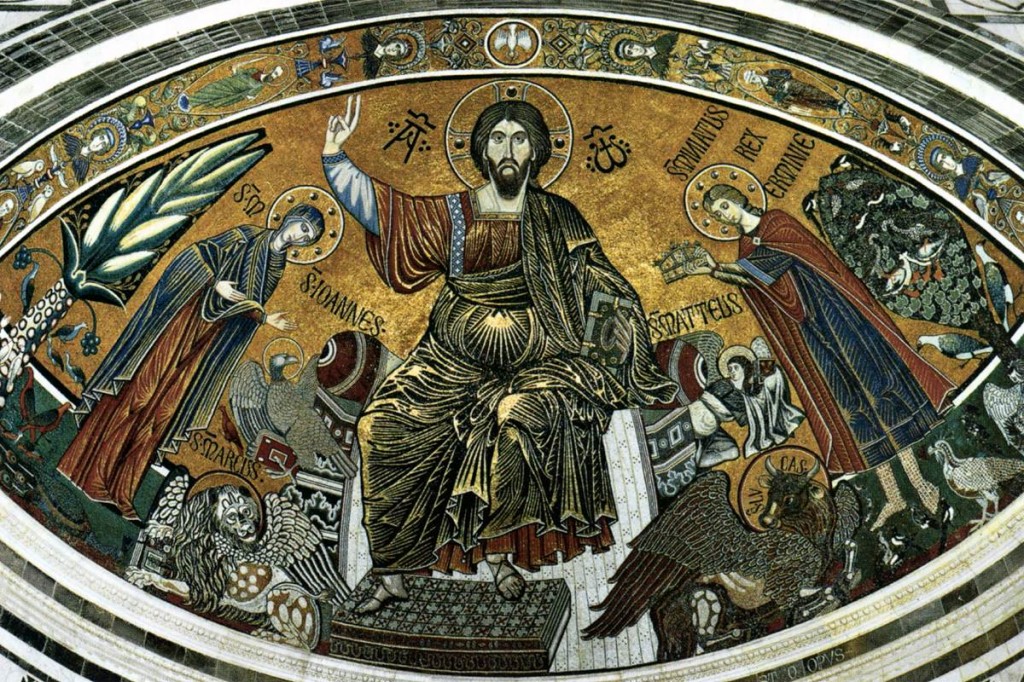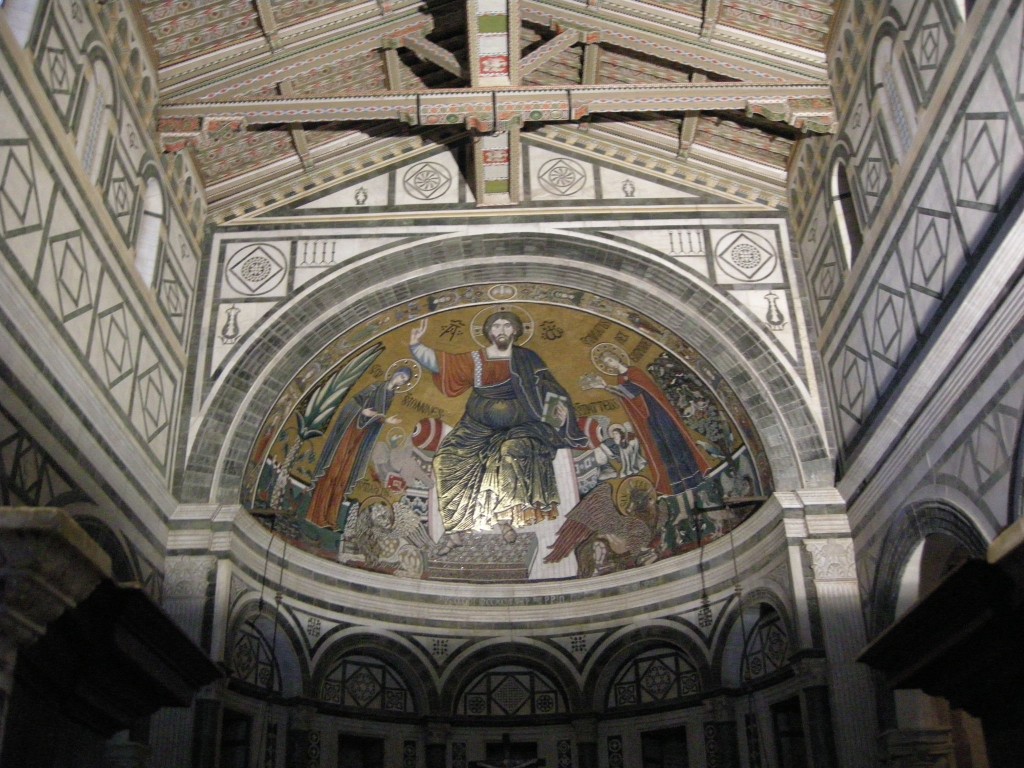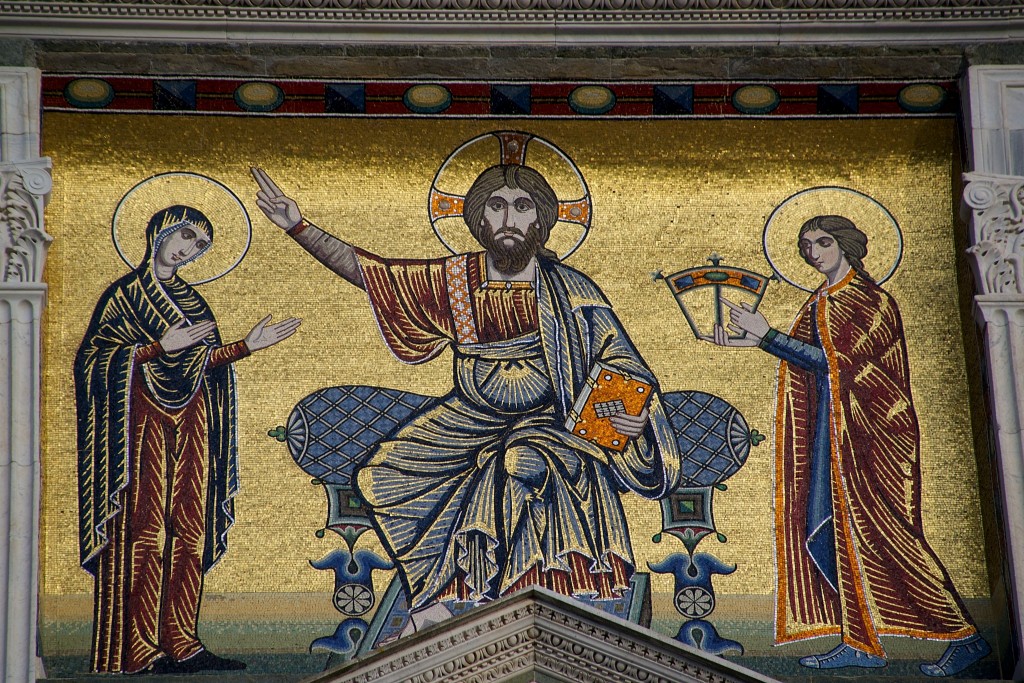A Pregnant Christ?! January 23, 2014
Author: Beach Combing | in : Medieval , trackbackThis beautiful mosaic is an eleventh-century work in the church of San Miniato in Florence, one of the most extraordinary religious buildings in the world. The mosaic is unusual as, though put together in central Italy, it shows, as does an accompanying mosaic outside the church, clear eastern influences. Are we to think of itinerant workmen from Greece or even beyond or would a couple of Venetians have been enough to explain this rather peculiar outsourcing of the orient in balmy Tuscany? Still more peculiar is Christ’s form. It is often noted by visitors that Christ is somewhat overweight. But it is more likely that Christ is ‘with child’. Certainly, there is an Eastern Christian tradition of portraying Christ as an expectant father/mother: though this morning an hour in Beach’s bookshelves and on the internet have failed to turn up any other examples. Google jumps to predictable conclusions once you type ‘Jesus’ and ‘pregnant’ and offers lots of sites were Evangelical fanatics and rude atheists repeatedly head butt each other about the Virgin birth. Can anyone help expand the field? drbeachcombing AT yahoo DOT com
But what is the sense of making Christ pregnant in this way? Perhaps he is pregnant with possibility, pregnant with salvation, pregnant with the new world he alleged (or his biographers) alleged he was bringing. Eliot said it preciously but well: ‘were we led all that way for/ Birth or Death? There was a Birth, certainly,/ We had evidence and no doubt./ I have seen birth and death,/ But had thought they were different; this Birth was/ Hard and bitter agony for us, like Death, our death.’
There is also that extraordinary line in Paul’s letter to the Galatians, one of the most attractive in the Bible: ‘There is neither Jew nor Gentile, neither slave nor free, nor is there man and woman, for you are all one in Christ Jesus.’ Maybe Christ is here transcending the most fundamental of all divides, the one between male and female? The bearded lady who would die on the cross: it is a new way of thinking about salvation. The flanking figures, one man, one a woman, do bend into Christ: Mary on the left and Minias (the patron of the church) on the right. The merging is accentuated by the fact that the mosaic has been created across a curved surface and in the medieval dark of the church (of course the photographs don’t do justice to the dark) with flickering candles, and monks chanting, the effect is, well, bewildering.
There is also, as noted above, a Christ outside. But he is not in the third trimester: see below.
23 Jan 2014: Invisible writes in, my comments below: Are there actual Byzantine texts referring to the Motherhood of Christ? Barring actual theological explanations, what I see in here (as well as in some other Byzantine or Eastern Orthodox representations of Christ Enthroned/Pantokrator) is simply a stylized way of representing the folds of the outer garment (some version of senatorial toga, in my opinion) around the waist. Like this one at Hagia Sophia. Or this one at Pisa, also a bit thick about the middle. Perhaps this was a regional variation of the Pantokrator? Or this 17th century icon This explanation of the iconography of this icon also explains the girding of the waist as a symbol of Christ’s humanity. If you look at a group of enthroned Christs or Pantokrators, nearly all have the mantle wrapped around the stomach. This is just a particularly clumsy representation. Of course, “the firstborn over all creation” verse from this post might also suggest the paradox of the Creator created. And you do have Julian of Norwich writing about the Motherhood of God, but she’s a long way from Italy, several centuries too late, and the notion borders on heretical. I am no theologian or Eastern Christian scholar, but if I were just speaking as a student of iconography, I would think that the “pregnancy” is nothing more than pareidolia.’ I [Beach] should say that I first heard this theory from a resident monk but I’ve also heard this said about some Istanbul Christs. Perhaps three possibilities: (i) there was a Christ is pregnant iconography; (ii) there was not but the dress was reinterpreted in this light late in the Middle Ages; (iii) the whole Christ is pregnant thing is a modern urban legend. KMH goes straight for the common sense jugular (and he may have a point): Three-dimensional perspective probably wasn’t used with mosaics for church buildings in the eleventh century. Christ’s protruding belly may simply be an optical illusion due to our post-renaissance habit of seeing all pictures in three dimensions, and “accentuated by the fact that the mosaic has been created across a curved surface.” Keeping everything in perspective. Thanks to Invisible and KMH!
31 Jan 2014: Ashley Pond writes in I’m too old at this point, and art history was only my minor, but pregnancy was sometimes depicted as a symbol rather than a fact. The above portrait being a prime example though as I recall there are others. I just don’t recall them. 😛 The Dutch school and what appears to be the art style of the Eastern Church, as you note, having no obvious connection however, I offer this merely as food for transubstantiation. Thanks Ashley!






